The 2018 Apple iPad Pro (11-Inch) Review: Doubling Down On Performance
by Brett Howse & Andrei Frumusanu on December 4, 2018 10:00 AM ESTThe Liquid Retina Display
Apple offers some of the best displays on the market, and the iPad Pro is arguably their best display available. What Apple calls a Liquid Retina display is a 264 pixel-per-inch masterpiece. The 11-inch model we are reviewing holds a 2388x1668 7:5 aspect ratio panel, while the larger 12.9-inch model uses a 4:3 2732x2048 panel.
There’s a lot that sets Apple apart from other manufacturers on the market. The company has taken display accuracy seriously longer than anyone outside of the professional field. The display in the iPad Pro is also a P3 D65 gamut display, but thanks to the color management system that Apple moved over from the Mac, it simultaneous offers near-perfect sRGB reproduction as well as near-perfect P3 reproduction whenever an app or image specifically says it's P3. There’s no compromise on offering the P3, and no need to change the gamut on the display to match different color spaces. It’s a P3 display where sRGB is properly mapped.
In addition, Apple’s iPad Pro offers their ProMotion technology, which means it is a 120 Hz display, but one that supports variable refresh rates in order to lower the display's refresh rate for power management purposes. The iPad Pro will go as low as 24 Hz, presumably chosen to match the framerate of most movies. Apple also carries over its True Tone functionality, where ambient light sensors change the white point of the display to make it more suited to the environment it is in. It’s one of those features you never really knew you needed until you see it in action.
The fully laminated display also offers Apple’s industry leading antireflective coating, which Apple rates at 1.8% reflectivity, improving the results outdoors dramatically over most devices, and of course there is a fingerprint-resistant oleophobic coating as well.
Apple rates the latest iPads at up to 600 nits of brightness too, so pretty much no matter where you are, the combination of the high brightness and the antireflective coating should make for a great viewing experience.
To test the display characteristics, we turn to SpectraCal’s CalMAN software suite, along with an X-Rite i1Display Pro colorimeter for brightness and contrast readings, and the X-Rite i1Pro 2 spectrophotometer for color accuracy readings.
Brightness and Contrast
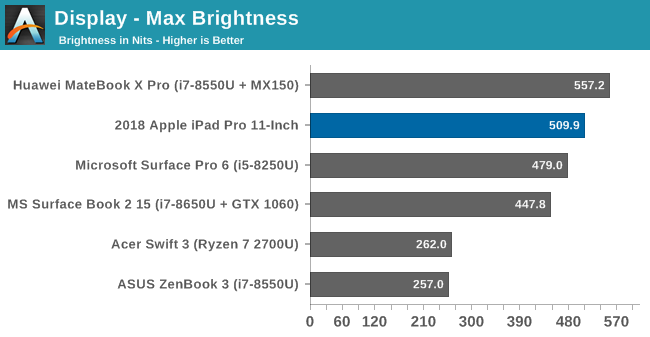
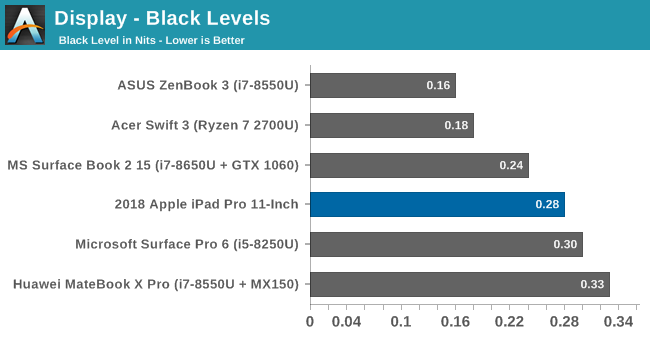
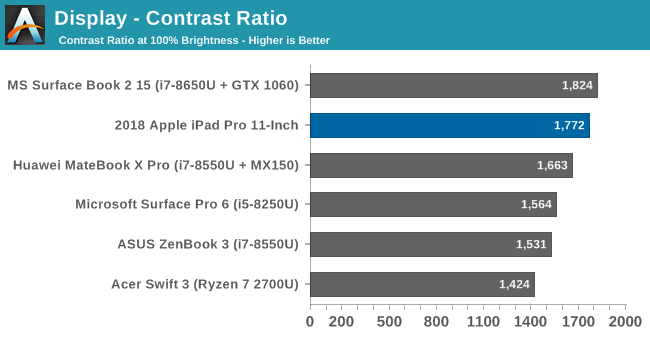
Under our test conditions the iPad Pro could not quite hit the 600 nits that Apple advertises, but at 500 nits it is still plenty bright. Couple that with the excellent contrast ratio of almost 1800:1, and things are off to a good start.
Grayscale
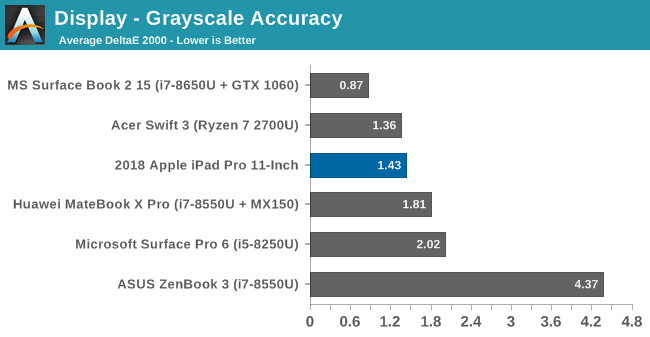
The average dE2000 of 1.43 is a fantastic result, but the gamma isn’t quite perfect, dropping off near 100% because the display was slightly too bright. Unfortunately, the red results were quite low throughout the entire range leading to a slightly cooler display white point, but this is all quite minor.
Gamut
First let’s take a look at sRGB:

As you can see, the sRGB values are almost perfectly mapped into the P3 D65 gamut, and the average error level of just over 1.09 is simply fantastic. All of the primary and secondary values are close to perfect, except red which was a bit low at 100% red, as we saw in the grayscale results.
Next up, P3 D65:
As with the sRGB results, the P3 D65 gamut is also almost perfect. The beauty of color management means that there’s no work for the user to get the benefit of both P3 and sRGB.
Saturation

The saturation sweep was run in sRGB, and as you can see from the graphs, all along all of the primary and secondary colors the error level is basically imperceptible to the human eye.
Gretag Macbeth
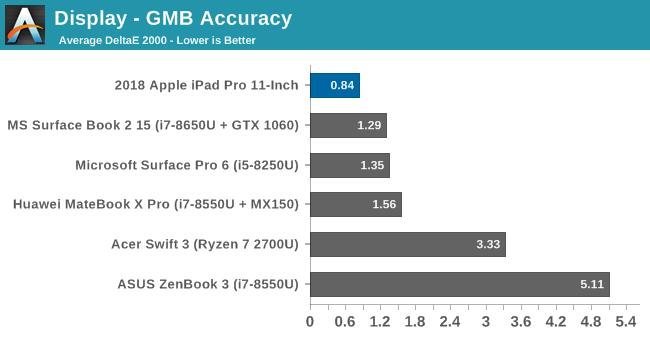
Finally, the Gretag Macbeth test is a more comprehensive test, hitting colors outside of the primary and secondary colors, including the important skin tones. The error level is practically perfect, with no single color even hitting an error level of 2.0.
Display Conclusion
The iPad Pro simply offers one of the best displays on any electronic device. Color accuracy is superb, in both the P3 and sRGB gamuts, and thanks to iOS supporting full color management, customers don’t have to worry about if they are working on a P3 or sRGB image. The addition of True Tone makes for an incredibly pleasing white point in pretty much any situation, and the 120 Hz display refresh rate makes for smooth scrolling, while stepping down to lower refresh rates to conserve power when the display is static.


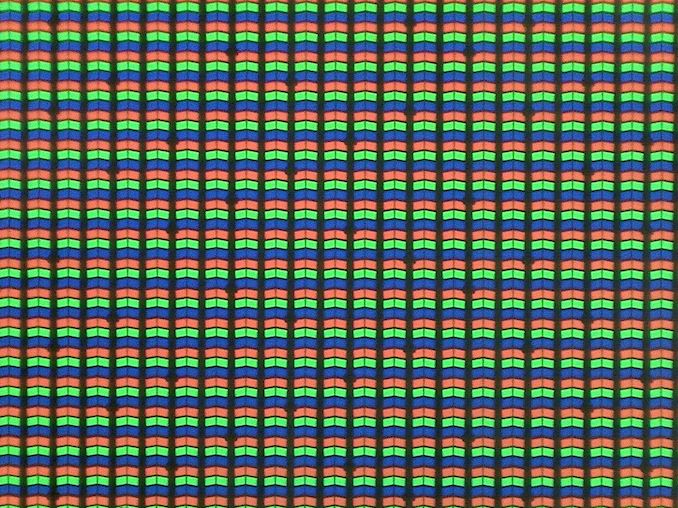


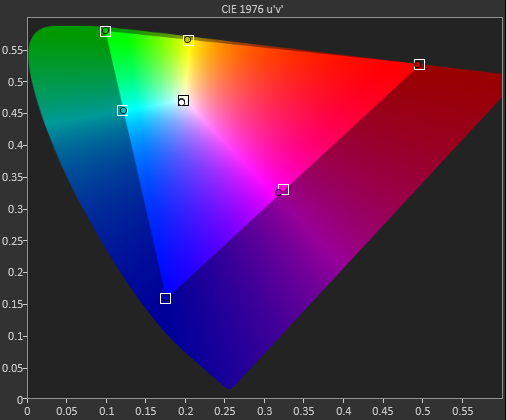










145 Comments
View All Comments
Ryan Smith - Tuesday, December 4, 2018 - link
Unfortunately we don't have that one. These go back to Apple when we're done.MonkeyPaw - Tuesday, December 4, 2018 - link
I have the 2017 12.9” 64GB model, though I’m not on staff and don’t have your benchmarking suite.MonkeyPaw - Wednesday, December 5, 2018 - link
Not sure how this will for,at on this comment system, but here is what I got on my 2017 iPad Pro 64GB;TabletMark 2017
Overall: 1404
Web-Email: 1438
Photos-Video: 1372
Speedometer 2.0: 89.0
WebXPRT 3.0: 131
Kraken 1.1: 856ms
Slingshot 3.1 Extreme:
Graphics: 6,514
Physics: 2,602
Ice Storm Unlimited
Base: 55,609
Graphics: 118,335
Physics: 19,482
GFXbench Aztec Offscreen
High: 21.5
Normal: 59.3
melgross - Tuesday, December 4, 2018 - link
They supply a 1 meter USB C cable because the usb 3.1 gen 2 spec for data transfer is 10Gbs for 1 meter, but 5Gbs for anything longer to about 3 meters, where it then peters off to about 3G s to about 4 meters.I imagine they’re concerned that people will complain that they’re not getting the 10Gbs speeds, and blame Apple and the iPad for that if they give a longer cable. Apple has difficulty communicating these problems for some reason. They should just state the data transfer speeds with different cable lengths so that people understand what they’re doing. I have a few USB 3 to USB C charging cables, and none are usb 3 anything. They’re all usb 2 cables with a 480Mbs transfer rate. Most people don’t understand the totally screwed up spec that usb is.
tipoo - Tuesday, December 4, 2018 - link
They only use USB 3.0 anyways, so not that.melgross - Tuesday, December 4, 2018 - link
What? It’s 3.1 gen 2. Just go to their site and read the speed spec for yourself..tipoo - Monday, December 10, 2018 - link
I don't see 3.1 gen 2 anywhere on their specs sheethttps://www.apple.com/ca/ipad-pro/specs/
Last news I heard was the iPad Pros were the first to move to 3.0 while the phones were still on 2.0, I don't see anything corroborating 3.1 gen 2 on a quick google for the new ones.
https://www.cultofmac.com/397412/ipad-pros-sneaky-...
gailthesnail - Thursday, December 20, 2018 - link
The iPad pro's USB 3.0 functionality is heavily restricted and is only enabled for the lightning to SD card dongle. Anything else like connecting to iTunes to transfer media is limited to USB 2.0 speeds. This is what I've experienced so far on my 2017 iPad pro 10.5. I'm not 100% sure but I think it's the same for the new iPad pros as welltipoo - Tuesday, December 4, 2018 - link
I hope iOS13 does remove most of the hurdles with working off iOS. The power is clearly there, if you chart out Apple device performance per dollar the 11 inch Pro is way ahead of the Macbooks, but you just can't do as much on it.Something as simple as working off of media off an external hard drive which you take for granted on any traditional OS you just can't do here. External hard drives aren't natively supported at all. Then there's lack of a trackpad and a cursor for fine text selection, Xcode, etc etc.
All this power seems like it was meant for an OS that was pushed back in favor of polish, and hopefully 13 really unleashes it.
HStewart - Tuesday, December 4, 2018 - link
IOS and Mac OS ( or Windows ) are different OS - iOS is app centric OS while Mac OS and Windows is desktop centric OS. Apple is unfortunately in delusion that iOS and iPad Pro can replace the desktop / laptop devices.Even with Photoshop Creative Cloud on it - it nothing like the Photoshop CS5 ( which I owner ) and in my opinion it just and over larger iPhone.